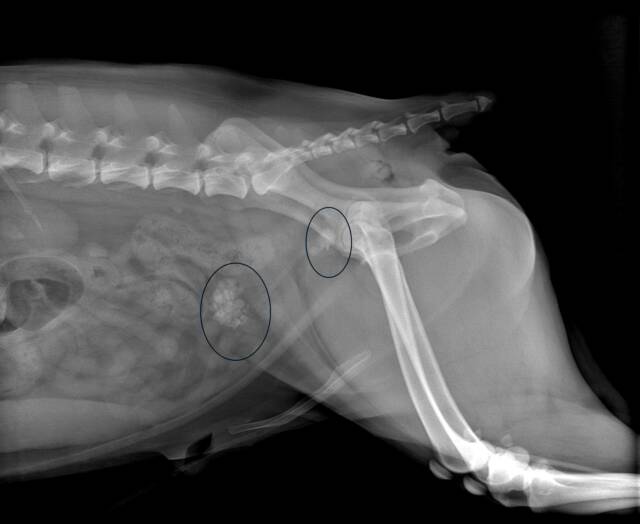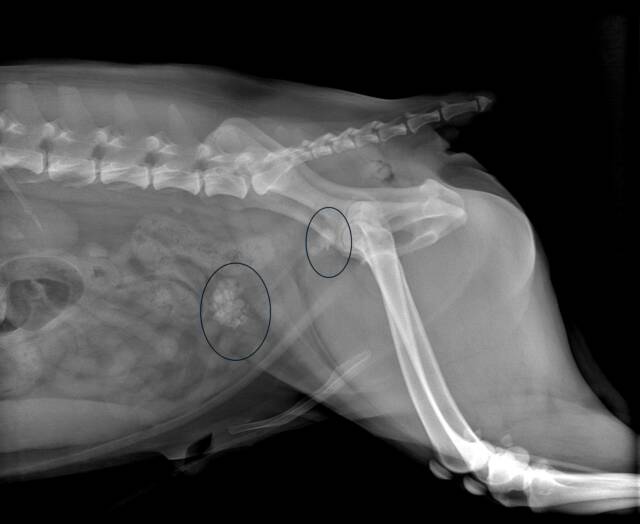
Clinical signs of bladder stones to look out for
Dogs with bladder stones often present like dogs with a bladder infection. Both of these conditions will show frequent urination as well as discomfort, particularly when urinating. The animal will squat to urinate frequently, often only passing small amounts of urine while straining. The owner might also see a red discoloration in the urine and in some cases the urine can be a dark red colour. Because the stones rub against the bladder wall it causes irritation and inflammation of the bladder wall that leads to bleeding. Some dogs will show discomfort and pain when walking, with the hindquarters tucked in, while cats can become very vocal when in pain. In some cases the stones may still be very small and can leave the bladder and enter the urethra. The urethra is the tube that directs urine from the bladder to the outside. If the stone is not small enough to pass, it will become lodged in the urethra, blocking urine flow completely. The pressure will build up in the bladder and the kidneys, and if this is not corrected quickly, the bladder can rupture. This will cause severe illness and if quick intervention is not done it may lead to death.
Diagnosing bladder stones
Depending on the size and amount of stones present, the vet may be able to diagnose bladder stones on palpation of the bladder through the abdominal wall. Palpation is the process of using one’s hand to examine the body. It may feel like a bag of marbles or a bag of fine sand. A full analysis of the urine (urinalysis) must be done to make an accurate diagnosis. With this you can measure the urine pH and other parameters that provide useful information regarding the condition. Bladder infections play a big role in stone formation and a urinalysis will pick this up effectively. Diagnostic imaging like x-rays and or ultrasound needs to be considered as the next step as part of a comprehensive non-invasive workup to complete the diagnosis. X-rays can pick up radio opaque stones in the bladder, meaning the stones can be seen as white round bodies in the bladder. One has to include the whole urinary tract in these images to ensure there are no stones in the kidneys, ureters and further down in the urethra. In cases where stones have not mineralised yet or contain a lot of mucoid material, it may not show up on X-rays. A special dye or even air can be injected into the bladder to make them more visible. An abdominal ultrasound can also be very useful to pick up these stones.
Treatment of bladder stones
To understand the treatment, we need to have a look at how these stones are formed in the first instance. Stones are formed by minerals in the urine. If the mineral concentration is high and the urine becomes super saturated, the salt will start precipitating out. The urine is normally slightly acidic, and at this pH it keeps the minerals in solution. When the pH rises the salts precipitate out easier. With bladder infections there are bacteria in the bladder that increase the pH and this will increase the likelihood of stone formation. If the bladder is infected there may be a lot debris and mucoid material floating in the urine. This debris can concentrate and form a nidus that enhances stone formation. The different types of stones most commonly encountered are struvite stones, calcium oxalate, urate, cysteine and calcium phosphate. Each type of stone will form under different conditions and different pH in the urine. Struvite stones are the most common and are also referred to as “infectioun stones”. These stones form when the pH increases, which happen with infection. It is important to send urine away for culture and antibiogram testing to make sure the infection is treated with the correct antibiotics.
The treatment for bladder stones may require surgical removal of the stones from the bladder by performing an incision into the bladder called a cystotomy. An incision is made into the bladder wall and the stones are removed by hand or with a blunt object. A catheter is passed into the urethra to make sure there are no stones blocking the urethra further down. The bladder is then flushed with saline solution and the incision closed with an inverting suture pattern. Stones must always be sent away for analysis as this will provide information on how to prevent stone formation in the future. Some stones in the early stages of formation can be dissolved medically by changing the urine pH. This may take some time and will definitely not work with all types of stones. Stones lodged in the urethra must be flushed out, or back into the bladder and be removed from the bladder.
After the initial medical treatment of bladder or surgical removal of bladder stones, your pet may need a change of diet to prevent stones from forming again. There are specific diets on the market for specific types of stones and depending on which stones your pet had, the vet will place him or her on the correct specialised diet. Stones can easily form again after surgery if the diet and medical treatment is not done correctly and therefore regular checkups with the vet will be required after the initial diagnosis and treatment.
© 2018 Vetwebsites – The Code Company Trading (Pty.) Ltd.


